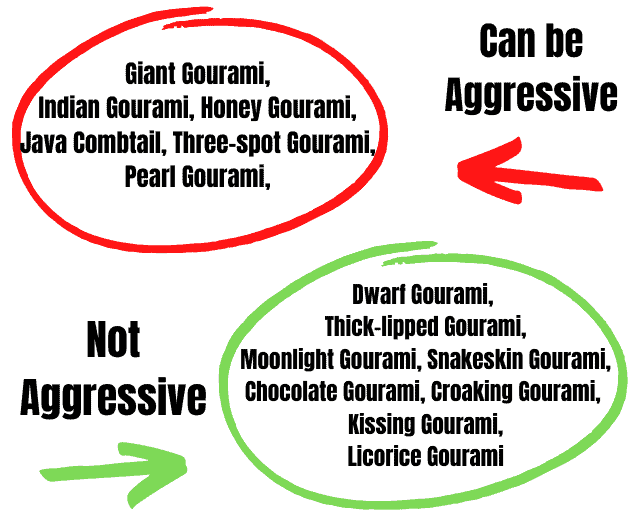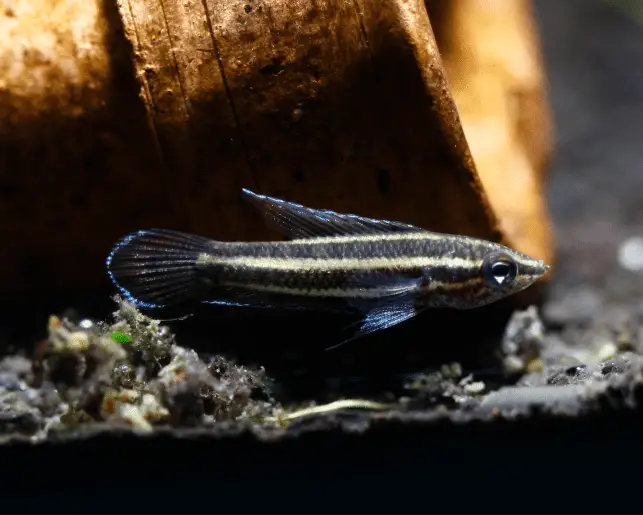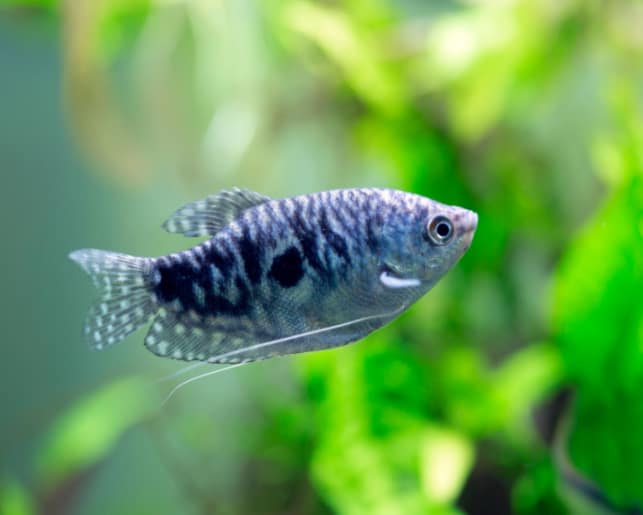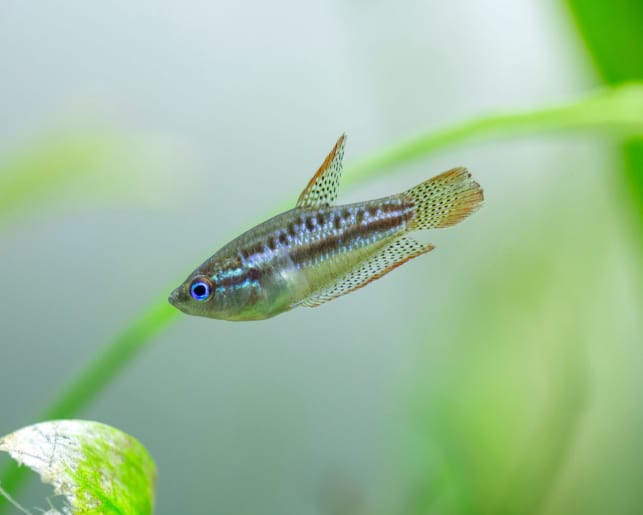Owning a community tank is always a popular choice when owning tropical fish, especially if you are new to the hobby.
There is a downside to having a community tank though. Sometimes trouble brews between different species, or within a species.
There is a way to drastically reduce any chance of this happening, which is to do your research before adding a new type of fish to your tank. This way, you will spend less time stressing over the stress levels of your fish kids, and more time enjoying how they all get along peacefully together.
In this article, I’m going to discuss if gouramis are aggressive, what can cause it, how to recognise it, and how to reduce it.
Are Gouramis Aggressive?
Some species of gourami are capable of showing aggression to other angelfish if they feel threatened, or are establishing a pecking order amongst themselves. They are not often aggressive to other species.
The illustration below separates which species of gourami can get aggressive in certain circumstances, as well as which gouramis are peaceful and social.

Reasons Why Gouramis can get Aggressive.
Establishing a pecking order.
This is completely normal behaviour with gouramis if you have more than one male. The group needs to establish who is the boss and who isn’t. This is usually decided by very low level aggression (known as sparring). It can get a bit more aggressive if some of the males refuse to back down though.
Not enough space.
Gouramis need space to swim, as well as space to hide away and take some time for themselves, so a big, roomy tank with hiding places is essential.
Use a stocking calculator, like AQADVISOR.COM to help you work it out. They take the shape of your tank into consideration, as well as the size.
Not enough food.
A hungry fish can be a very aggressive fish. Not feeding your fish enough is as bad as overfeeding them. Getting the amount right for your tank can take a few goes to get correct, but it is very important.
They are in spawning condition.
When male gouramis are in spawning condition, they could have a go at another fish if they annoy them. The male’s temperature increases when they are ready to spawn, and we all get a bit irritated when we’re too hot, don’t we?
They are protecting their fry.
Some breeds of fish are protective parents, who will show aggression to any other fish that comes near their fry.
Gouramis are not protective parents at all. Any aggression shown by gouramis when eggs have been laid will be because they class the eggs as food and don’t want other fish eating it!

How do Gouramis Show Aggression?
There are other reasons why gouramis look like they are showing signs of aggression, when in fact, it is not as bad as it looks.
Sparring.
Sparring amongst gouramis is completely normal when they are in a group with more than one male. This is how they sort out their pecking order. The 2 sparring fish will face each other and their heads will twitch then they back off, swim around a little bit and then do it again. They will repeat this until they get bored (or distracted).
Sparring can also occur around food.
Mating.
When gouramis are mating, it looks very similar to when they are being aggressive to each other.
It is fairly easy to tell the difference between a male and female gourami. The females tend to be larger, while the males are more vivid in colour.

Here are a few things for you to look out for, to help you decide if your gouramis are actually being aggressive, which could threaten the health or well-being of your other fish.
Signs of aggression to look out for.
- Their fins spread, or stand up rigid, rather than flowing in a relaxed manner.
- Enhanced colouring.
- Darker eyes.
- Twitching head.
- Skittish behaviour.
How to Reduce Aggression in Gouramis.
Correct male to female ratio.
I would always recommend having your male to female ratio as 1 male to every 3 females. It is the males that are most likely to show any aggression and that is usually towards other male gouramis. However, if there are more males than females, they will start to harass the females when they are spawning, which will then lead to the females getting very stressed.
Having all females is a good idea if you have no interest in breeding. The females are pretty easy-going.
Correct tank size.
This is essential no matter what types of fish you have. One of the main reasons why fish get stressed is because they don’t have enough space. This can result in fish hiding away, or fighting with their own type, or other breeds, because they feel trapped.
Always make sure you don’t overstock your tank. When calculating how many fish can fit into your tank, you have to calculate using their adult size, not the size they currently are. Always try and understock slightly to be on the safe side.
As well as considering the size of your tank, you also need to think about the shape of it as well. Gouramis like lots of space to swim and play, so is best to be quite tall as well.
Have hiding places.
Having some ornaments and plants in your tank is always a good idea. You don’t have to have real plants either, the imitation ones do their job in providing shelter or hiding places for fish for when they need to just have a moment to themselves.
Fish can feel exposed when in a stressful situation so it is good to have somewhere for them to retreat to. Having a hiding place or a bit of shelter makes the fish feel a lot safer.
Just always make sure that you don’t fill your tank up with things so much that your fish have no room to swim and have fun, as that can be just as stressful as having nowhere to hide.
Keep the correct number of gouramis.
Keeping two gouramis is fine if you have one male and one female, or both females.
When you go higher than two, I would suggest keeping to the ratio I mentioned earlier on (one male to three females) so as to keep stress levels down between them.

Feed them the correct amount.
When you are new to fishkeeping, you are always told that you should never overfeed your fish. It is just as important that you don’t underfeed them as well, as that can also have a damaging effect in your tank.
Hungry fish can be aggressive fish as they may have to race to get to the food first if you aren’t feeding them enough.
It really is a case of trial and error at first when it comes to feeding your fish the correct amount.
A rule of thumb is that all the food you feed your fish should be eaten within 3 minutes. If your fish finish eating everything well within that time, you are not feeding them enough. If, after three minutes, there is still a lot of food floating around the tank, you are feeding them too much, so remember to adjust what you give them the next time you feed them.
Take a look at this video showing aggression in Dwarf Gouramis over food.
Get your timing right.
It is best to add your gouramis to the tank at the same time, and preferably when they are juvenile.
If you were to add gouramis to a tank that already has some in it. This could cause a problem. The fish in the tank will already have sorted out their pecking order and will be more than a bit miffed at new fish being added.
Best Tank Mates for Gouramis.
You also don’t want any fish that like to nip at dangly bits in with your gouramis as their whiskers are quite delicate. With this in mind, I would keep away from naughty fish like Tiger Barbs and Serpae Tetras.
A popular choice of tankmate for gouramis are corydoras. They tend to just hang out in their own little group, mooching around the bottom of the tank for bits of food, and are mostly very peaceful. Some of the other smaller gouramis or larger tetras are also fine as tankmates.

Conclusion.
Gouramis can make a colourful addition to a community tank, provided you don’t overstock your tank by adding too many fish in.
Male gouramis can show aggression to other male gouramis, but this can be greatly reduced by using common sense and making your fish as comfortable and stress free as possible.
Related Articles:
How many gouramis can I fit into a tank?
Why is my gourami staying at the bottom of the tank?

